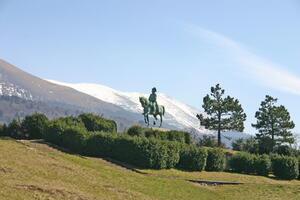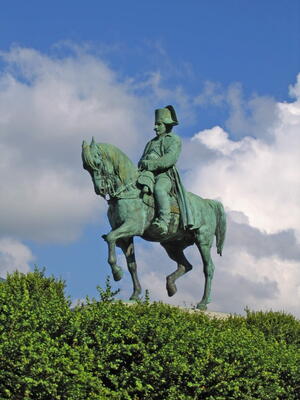Get your kicks on Route Napoleonics!
Some two hundred years ago in Volonne, a village located 60 kilometres upriver from Cadarache, a villager engraved a stone plaque to commemorate what he considered a major historical event. The plaque read: "Eishi lou 5 de mars 1815 Napoleon 1É P.P." Although it is written in Provençal—only few people in Provence spoke French at the time—it is quite easy to translate, except for the last two letters, which are rather cryptic: What did Emperor Napoléon do in Volonne on 5 March 1815? Well, he passed through the village—that's the first "P" — and he urinated on the wall—that's the second "P".
The plaque commemorates a very small event in a much larger story: Napoléon's return from the island of Elba, off the coast of Italy, where he had been exiled ten months earlier by a coalition of half a dozen European nations. On 26 February 1815, the fallen Emperor and a handful of his followers managed to escape house, or rather island, arrest. After one night at sea, the party landed at Golfe-Juan, near Cannes. Their intention was to reach Paris and reclaim the imperial crown. Careful to avoid the main thoroughfares, Napoléon chose to cut across the southern foothills of the Alps. This is how, after having reached Digne on 4 March, he arrived in Volonne the following day. The original party had swelled into a small army by then—Napoléon still had many supporters in the country he had ruled from 1799 to 1814.
The watershed event occurred on 7 March at Laffrey, a mountain village located half-way between Gap and Grenoble. There, in what was to be known as the "Clearing of the Meeting," the Emperor faced the troops that the newly restored monarchy had sent to stop him. "Here I am," said Napoleon, "Kill your Emperor if you wish!" Instead of shooting, the royalist troops cheered him and the road to Paris was left open.
Following these events, Napoléon was to rule a mere hundred days, ending with the battle of Waterloo on 18 June 1815. The Corsican-born Emperor was deported again—this time to the Southern Atlantic island of Saint-Helena, where he died in 1821.
The "Route Napoléon," the RN85, winding through Cannes, Digne, Sisteron, Gap and ending in Grenoble commemorates the events, large and small, that punctuated the Emperor's odyssey through Provence. Plaques and statues remind us that Napoléon slept here, ate there ... and "P." on a wall in the village of Volonne.




